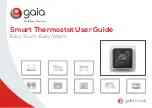
The hot water can be manually switched on and off by using the
‘Boost 1 Hr’ button on the SCR in a fault situation, even though
the red LED will stay on until a satisfactory signal is reinstated.
When the hot water is turned on by pressing the ‘Boost 1 Hr’
button, it will time out after 1 hour and return to OFF.
the DC RF unit.
the DC RF unit are
the DC RF
the DC RF
Proper Battery Recycling
Electronic devices and batteries, rechargeable or not, should not be
disposed of into ordinary household waste. Instead, they must be
recycled properly to protect the environment and cut down the waste
of precious resources. Your local waste management authority can
supply details concerning the proper disposal of batteries.
In compliance with the EU Directive 2006/66/EC, the button cell
battery located on the printed circuit board inside this product, can be
removed at the end of product life, by professional personnel only.
Unclip the housing to show the terminal block. First, connect a 2-core
cable to the DC RF transmitter, cut to the required length to
reach the sensor position. Connect to the sensor in the position shown
and fold wires back through the cable grip & out through the cable
entry, re-assemble the housing.
Signal Strength
Before fixing the DC RF to the wall it is recommended to first
check the signal strength from that location.
To do this, remove the batteries, press and hold the ‘set’ button whilst
refitting the batteries, keep the ‘set’ button held and after a few
seconds the display will show ‘rF’ which indicates that the DC RF
is continuously sending an OFF signal to the SCR (receiver). Leave the
DC RF
in position and return to view the SCR. If the red LED is
continuously flashing, this indicates a good signal. If the red LED is not
flashing, this indicates a poor signal and you need to reposition the
DC RF
until the red LED is flashing.
When the signal strength has been confirmed remove the batteries to
cancel the test and follow the installation instructions.
Relevant EC Directives:
Applied Standards:
230V a.c.
of walls between the DiC RF and SCR.
+0/-8
230V a.c.
24V a.c./d.c.
(BS7671).
2006/95/EC Low Voltage Directive
2004/108/EC Electromagnetic Compatibility
Directive
1999/5/EC R&TTE Directive
2006/66/EC Battery Directive
EN60730-1; EN60730-2-9
ETSI EN 300 220-3, ETSI EN 301 489-3
2011/65/EU RoHS Directive
Temperature Range:
40°C to 70°C
Industry Standard Wallplate
2
A
2.5Kv
75°C
Mounting:
Pollution Degree:
Software Class:
Pollution Degree:
Software Class:
Rated Impulse Voltage:
Ball Pressure Test:
2
A
Energy Class: I = 1% (According to EU 811/2013,
812/2013, 813/2013, 814/2013)




















